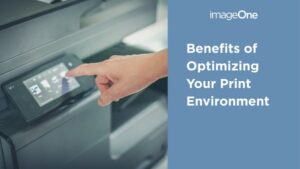Within a busy workplace, one of the most common printer-related questions posed to the tech or IT team is—“does the printer or copier’s toner need to be replaced?”
It seems like an easy enough question to answer. Once the “toner running low” alert flashes on, it’s time for a new cartridge, right?
Not quite. There are actually several factors to consider before making the switch—and understanding exactly what these factors are can save your business a surprising amount of money. Over time, these savings can easily reach into the thousands!
When To Change The Toner
If you don’t have a managed print partner, it’s up to you to know when to replace your office printer’s toner. Most of the time, the default setting alerts users when toner supplies are running low. Usually, this goes off when about 10%-20% of the toner supply remains.
This little reminder is better than nothing. However, it’s often not the most financially sound advice for your machine. That’s because, depending on the printer and the type of toner cartridge, there could be thousands of pages or months of toner remaining before it’s really “out.”
So, if you are paying out-of-pocket for your toner cartridge, you’re basically throwing money away if you swap them out too early.
How Much Time Do I Have Left On My Cartridge?
Before deciding when to change your toner, consider what type of toner you have in your printer. Since different types of toner can last longer or shorter than others, this can help you estimate when a switch is due.
There are three standard types of toner:
- A compatible cartridge is a remanufactured (think recycled) cartridge. It will likely have the lowest cost of the three, but the highest likelihood to dry up early or be defective. This is a great option if you’re looking to save money.
- The standard cartridge is your run-of-the-mill cost savings cartridge. It typically gives you about 10,000–12,000 pages. For a home user that doesn’t print constantly, this is a great option.
- The high yield (sometimes called a jumbo cartridge) is the preferred cartridge option for most corporate printers. For busy offices, they’ll give you the most bang-for-your-buck and offers upwards of 25,000–40,000 printed pages.
Also, do note that the actual size of the printer cartridge is directly related to the printer’s yield. A standard yield cartridge will appear smaller in size than a high yield version. The high yield will also fit more snuggly into your printer, but I assure you that it will fit your printer just fine. For more on the differences between standard and high-yield cartridges, as well as why choosing the right one can save you money, check out this blog.
Ok. Now for how to save some money!
Rather than just swapping out toner as soon as the alert light starts flickering, use that as the sign to start keeping a close eye on when to change your toner. Remember, you probably still have about 10–20% of the cartridge’s toner left. Tossing it now would be like burning up your hard-earned money. You’ll know it’s finally time for a replacement once the printed pages start to become streaky, lighter, or obviously of lower quality.
Instead, take note of approximately how many jobs are being completed. Say you’re using a high-yield print cartridge—once you start getting close to that 10% mark, or around 2–4,000 pages, start really looking for those signs that the cartridge is finally running dry.
Or, if you have been given control of the administrative settings on your devices, then you can also print a supply status page directly from your printer. The supply status page will list statistics including the percentage of remaining toner, page counts left for the cartridge, etc.
After checking the status, if the pages remaining on the toner exceeds the number needed to complete your next print job, then you are safe to print without concern.
The Exceptions to the Rule
Like with anything else, there are always exceptions to the rules. So, even if you’re doing all of the right things when it comes to maintaining and exchanging your toner cartridges, things can still go wrong.
One common issue is those times when cartridges run out earlier than expected, or without warning. This kind of cartridge failure does happen, and it’s not something you can accurately predict. Unfortunately, defective cartridges sometimes just happen.
Think this might be happening with your printer? We suggest visually inspecting your most recently printed pages. If your print jobs have been consistently printing too light, then the cartridge probably has reached the end of its life even if it seems to too, or whether the alert light is on or not.
To prepare for this occasional—but potentially headache-inducing—problem we always recommend having a backup set of toner on hand. You can order extra toner cartridges on your own, or if you have a print management partner, they should be happy to ship a backup set.
Do keep in mind that toner quality diminishes while on the shelf. Therefore, we would not recommend replacing a set of toner that has been in storage for six months or more as it will increase the likelihood of running dry early.
How Can a Print Management Service Help?
Generally, you should start paying close attention to your printer once its toner levels reach about 10%. This means looking for those too-light print jobs or low toner alerts while regularly checking printer status pages.
As you can imagine, or know firsthand, this can be a time-consuming process. Especially if you’re trying to save money by using every last drop of toner, you’ll have to keep an eagle eye on your printers—and don’t you have way more important things to think about?
That’s one reason why working with a professional managed print service, or MPS, can be a fantastic partnership. Rather than worrying about replenishing the toner inventory or watching its levels, the MPS provider will it for you.
Most MPS providers have a general rule of thumb to auto-replenish toner when supplies read 10% via their own data collection agent. This agent provides an hourly read of your printer’s supplies and delivers that data to the MPS. When supplies hit 10%, the managed print service will receive an alert that it’s time to ship you a new cartridge.
The only exception is for critical print devices which are usually shipped at 30%. Though any customer can ask for their machines to be considered critical, this usually applies to devices that fly through toner much faster than average. Any great managed print partner would rather have their toner arrive early than late.
With an MPS provider keeping an eye on your precise levels, they’ll inform you when it’s the perfect time to change out your toner. That way, you’ll always have the highest quality prints while saving as much money on your toner and print costs as possible.
Curious to see if a managed print service could be the right fit for your business? The team at imageOne would love to talk! Just book a 15-minute, no-obligation consultation with one of our friendly reps and we’ll discuss how we can help your business boost efficiency and save money.

.jpg)




